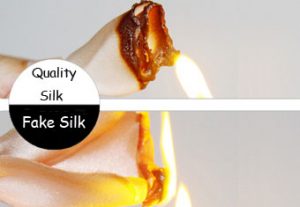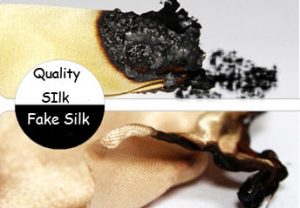“I have a Liberty of London nightgown ready for my shop and really can’t decide whether it is silk or not. Anyone got any foolproof ways of identifying real silk? I’ve read a little about the burn test but before I see whether there’s a bit of fabric I can snip out has anyone got any other ways of telling? Thanks.”
A netizen asked for help online.Many enthusiastic netizens replied that best bet is the burn test.

Customers have big doubts about its purity when they want to buy 100% natural silk home. Therefore, there are a number of ways for reference which can be used together to try to determine if a fabric is genuine silk or a synthetic man-made fabric that looks like silk.
- No doubt about it – genuine, Real silk usually costs at least ten times as much as synthetics to produce.
- It is a result of the combination of threads of different single colours in each of the weft and warp. This “shot” effect gives a surface that “shines” and appears to change colour as the angle of light on it changes.
- Silk can be hand-woven or machine-woven. Machine-woven silk will have a perfectly even weave with no flaws … and very little character. Hand-woven silk has its own individual characteristics. Each piece is unique.
- In the final.Genuine silk with a woven pattern will have the pattern visible on both sides but the pattern on the reverse side may appear slightly “fuzzy”. Burn Test.This is not a standard test you should perform on silk! However, it is a fairly definitive test.
Genuine silk will burn with a smell like burnt hair and will produce a black, powdery ash. It will only burn while the flame is being applied – take the flame away and the threads will stop burning.
A synthetic fabric will burn with a smell like burning plastic and will drip, form a black ball of residue (not ash), and produce black smoke. It will continue to burn even after the flame is taken away.

